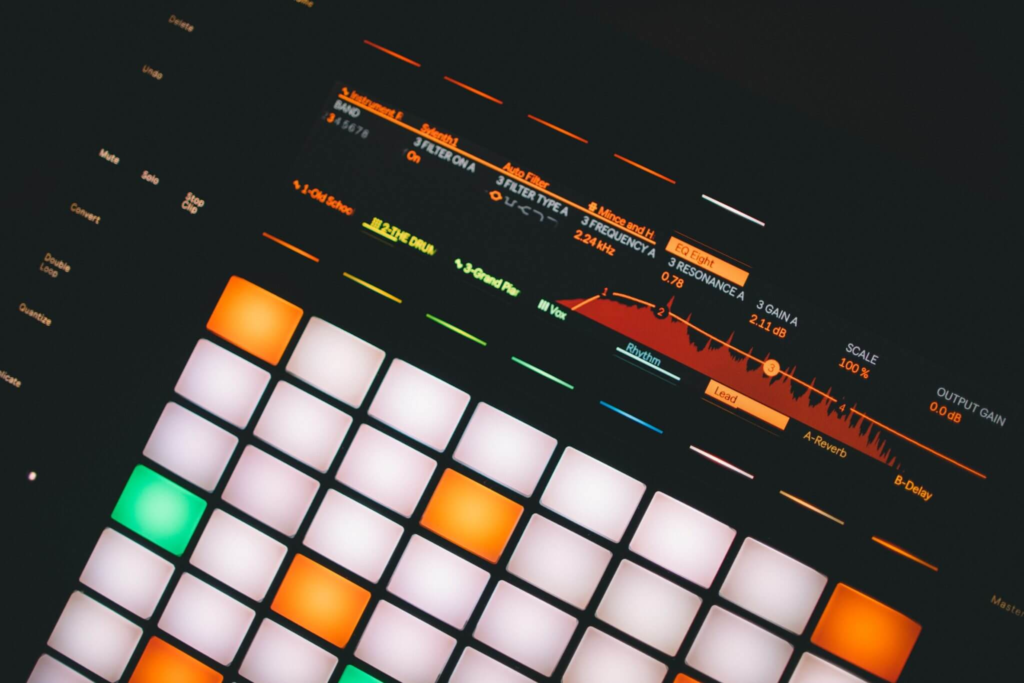From boom bap to trap, explore the fascinating evolution of hip hop beats. This journey through sound examines the key influences, technologies, and artists that shaped this iconic music genre.

Table of Content:
The Genesis of Hip Hop Beats
The genesis of its distinctive sound lies in the late 1970s and early 1980s, primarily within the vibrant and energetic party scene of New York City. This era, often referred to as “old school,” saw the birth of hip hop beats, a raw and innovative blend of funk, soul, and other musical influences.
Old School Hip Hop: The Beginning
Old school hip-hop beats, emerging in the late 1970s and early 1980s, represent the foundational bedrock of the genre. These sounds were raw, innovative, and deeply rooted in the funk and soul music that permeated the era. A key innovation of this period was the development of “breakbeat DJing,” pioneered by figures like DJ Kool Herc. Herc’s technique involved isolating and extending the instrumental “breaks” of existing records—those moments where the vocals dropped out and the rhythm section took centre stage.
The Roots of Hip Hop
The sonic landscape of early hip hop was defined by a distinct set of characteristics. Heavy, prominent basslines provided the foundation, while syncopated rhythms, often derived from funk and soul grooves, gave the music its infectious drive. Catchy hooks, whether vocal or instrumental, added memorable melodic elements. The “boom bap” style, with its characteristic kick drum and snare pattern, became a staple of this era, though it wasn’t the only style. Early hip hop producers and artists often relied on live instrumentation, incorporating elements of funk, soul, and even Latin music into their tracks. Before the widespread availability of affordable samplers, looping techniques were employed to create repetitive musical phrases, often using tape loops or by manually replaying sections of records.
The Golden Age of Hip Hop
- The Golden Age of Hip Hop, roughly from the mid-1980s to the early 1990s, was a time of incredible creativity and innovation. It’s when hip hop really came into its own, with artists pushing boundaries and experimenting with new sounds and styles. Think of it as hip hop’s teenage years – full of energy, exploration, and a desire to make something new.
- This era saw the rise of legendary artists like Run-DMC, Public Enemy, Rakim, and many more. They were masters of lyrical storytelling, often tackling social and political issues in their music. The beats were just as important, with producers using samples from funk, soul, and jazz to create unique and soulful soundscapes.
- The Golden Age was a time of diversity, with different styles and voices emerging from all over the US. It was a period of growth, experimentation, and ultimately, the solidification of hip hop as a major force in music and culture.

The Rise of the MPC and Digital Sampling
- Sampling as a Revolution: Sampling revolutionized hip hop production, fundamentally changing how beats were constructed. Producers began “digging” through vinyl records, discovering snippets of melody and rhythm to repurpose into new creations.
- Homage and Innovation: This practice allowed artists to both pay tribute to musical influences and simultaneously forge entirely new sonic landscapes. The iconic boom bap beats of the 1990s frequently relied on sampling, leading to the creation of classic hip hop tracks that remain influential today.
- Pioneering Producers: Producers like DJ Premier and J Dilla became pioneers of sampling, mastering the art of manipulating snippets. They crafted intricate, layered soundscapes that defined their signature styles and became instantly recognizable.
- Technological Evolution: As technology advanced, sampling techniques evolved alongside it, opening up new creative avenues. Digital production tools provided greater flexibility, enabling producers to manipulate, chop, and rearrange samples in increasingly sophisticated ways.
- Democratization of Production: With just a laptop and software, aspiring producers gained access to the tools needed to explore the vast potential of hip hop’s sonic palette. This accessibility democratized music production, empowering a new generation of creators.
- Continuing Influence: The evolution of sampling continues to shape the sound of modern rap beats, influencing contemporary artists and inspiring future generations of musicians. It remains a core element of hip hop’s DNA.
The Global Reach of Hip Hop Beats

- Technological Accessibility: The emergence of “new school” beats was intrinsically linked to the increasing accessibility of digital production tools. As technology advanced, software like FL Studio and Ableton Live became more readily available, lowering the barrier to entry for aspiring producers worldwide.
- Democratization of Beatmaking: This democratization of beatmaking empowered individuals across the globe to create and experiment with hip hop sounds. No longer confined to expensive studio equipment, producers in diverse locations could contribute to the genre’s evolution.
- Global Fusion of Styles: The experimental nature of “new school” beats facilitated a fusion of hip hop with other genres on a global scale. The influence of trap, with its heavy 808s and distinct hi-hat patterns, spread rapidly, blending with local musical traditions and creating unique hybrid styles in different countries.
- Cross-Cultural Exchange: The ease of digital distribution and online collaboration allowed for unprecedented cross-cultural exchange between producers. Artists from different continents could share ideas, samples, and techniques, leading to a globalized soundscape in hip hop.
- Expansion of Hip Hop’s Definition: The blending of R&B, pop, EDM, and other genres with hip hop beats expanded the very definition of the genre itself. This expansion wasn’t limited to one region; it occurred globally, reflecting the diverse influences and musical landscapes of different parts of the world.
- Global Artistic Embrace: Emerging artists worldwide embraced this evolution wholeheartedly. They experimented with various genres, incorporating local musical elements into their tracks and further demonstrating the global reach and adaptability of hip hop beats.
Regional Variations in Hip Hop Beats
Hip hop is a global language, but just like any language, it has different dialects. Think of the US as the main hub, and within it, different regions developed their own unique “accents” in their beats.
- East Coast: Imagine New York City – fast-paced, gritty, lots of stories to tell. East Coast beats often have that same energy. They’re known for their “boom bap” sound – hard-hitting drums, complex rhythms, and a focus on the lyrics.
- West Coast: Now picture California – sunshine, cruising, a more laid-back vibe. West Coast beats often reflect that. They’re smoother, more melodic, and often influenced by funk and G-funk. Think of it as the “chill” hip hop sound.
- South: The South brought a whole different energy to the game. Think hot summers, loud clubs, and a focus on the bass. Southern beats are often heavy, high-energy, and perfect for dancing.
Modern Hip Hop Beats: Trap, Drill, and Beyond

Trap’s Dominance: Modern hip hop beats have taken on vibrant forms, with genres like trap and drill leading the charge. Trap music is characterized by its heavy use of 808 drums, crisp hi-hats, and atmospheric synths.
- Drill’s Gritty Realism: Drill, emerging from Chicago’s streets, brings a darker edge to production. Its gritty basslines and rapid-fire percussion tell stories of urban life in raw detail. This genre’s intensity captivates fans worldwide.
- Beyond Trap and Drill: Beyond these styles are countless subgenres pushing boundaries further. Producers experiment with hybrid sounds, infusing elements from electronic music and even pop influences into their tracks.
- Evolution Reflecting Culture: The constant evolution reflects not just technological advances but also cultural shifts within society. Each new beat style captures the essence of youthful rebellion while driving conversations about social issues through creative expression.
- Beats as Social Commentary: Modern hip hop beats often serve as a vehicle for social commentary, driving conversations about important issues through their unique sonic textures and rhythms. They give artists a powerful way to connect with listeners and share their perspectives on the world.
Evolution of Hip Hop Producers and their Techniques
- Early Hip Hop Beats and Producers: The evolution of hip hop producers is a fascinating journey. Early on, beatmakers were often DJs who manipulated records live at parties. They created the classic hip hop sound using simple techniques, like looping and layering beats, laying the foundation for future hip hop beats.
- Sampling’s Impact on Hip Hop Beats: As technology advanced, so did production methods for hip hop beats. The introduction of sampling in hip hop changed everything. Producers began to pull snippets from funk, soul, and jazz records, shaping new hip hop beats that resonated with listeners.
- Digital Production and Hip Hop Beats: With the rise of digital production tools in the 90s and 2000s, creativity in hip hop beats exploded. Software like FL Studio and Ableton Live made it easier for anyone to create complex hip hop beats from their home studios.
- Modern Hip Hop Beats and Genre Blending: Today’s producers of hip hop beats are blending genres more than ever before. Trap beats dominate the scene while drill music introduces gritty sounds influenced by UK styles, showcasing the diversity of modern hip hop beats.
- Innovation in Hip-Hop Beats: Each producer brings unique techniques to their craft—driving innovation within this dynamic landscape of hip-hop music evolution, constantly pushing the boundaries of hip-hop beats.
Impact on Mainstream Music

- Hip hop beats have transcended their roots, infiltrating the fabric of mainstream music. The classic hip hop sound laid a foundation that many genres now borrow from, creating a rich tapestry of influence.
- Today’s pop stars often incorporate trap beats and 808 drums in hip hop to create chart-topping hits. This fusion has reshaped what is considered popular music. Artists like Drake and Cardi B seamlessly blend rap with catchy hooks, making tracks accessible to wide audiences.
- Moreover, influential hip hop producers are redefining song structures. Their innovative techniques inspire not just rappers but also artists across rock, R&B, and electronic genres.
- This evolution continues as beat trends shift toward more experimental styles. The impact on mainstream music is undeniable and ever-evolving—a testament to the genre’s versatility and staying power.

The Future of Hip Hop Beats
1. AI and Machine Learning: Imagine a future where AI can help producers generate beats, suggest melodies, or even create entirely new sounds. This could lead to faster production, more experimental sounds, and even personalized beats tailored to individual listeners. This exciting potential of AI in music creation, however, also brings its own set of benefits and challenges, which we explore further in our article on The Role of AI in Music Creation: Benefits and Challenges.
2. Virtual and Augmented Reality: VR and AR could transform how we experience hip hop beats. Imagine attending a virtual concert where the beats are visualized in dynamic ways, or creating music in a VR studio where you can manipulate sounds with your hands.
3. Genre Blending and Global Influences: Hip hop has always been a melting pot of musical styles. In the future, we can expect even more blending with genres like electronic music, Afrobeat, Latin music, and more.
4. The Rise of Independent Producers: With the rise of affordable technology and online platforms, independent producers have more opportunities than ever to create and share their music. This could lead to a more diverse and decentralized hip hop scene, where new voices and styles can emerge from anywhere in the world.
5. A Focus on Authenticity and Storytelling: As technology becomes more advanced, there may be a renewed emphasis on the human element in hip hop. Beats that are deeply personal, emotionally resonant, and tell compelling stories could become even more valuable.
Conclusion
The evolution of hip hop beats is a fascinating journey that reflects not just changes in technology but also shifts in culture and artistry. From boom bap’s raw energy to trap and drill’s complex rhythms, hip hop beats have constantly evolved. Sampling revolutionized production, weaving new sounds from old. Digital tools further democratized creation, opening doors for innovation. This journey reflects hip hop’s dynamic spirit, always pushing boundaries. The evolution of hip hop beats is a testament to creativity, technology, and the enduring power of rhythm.


